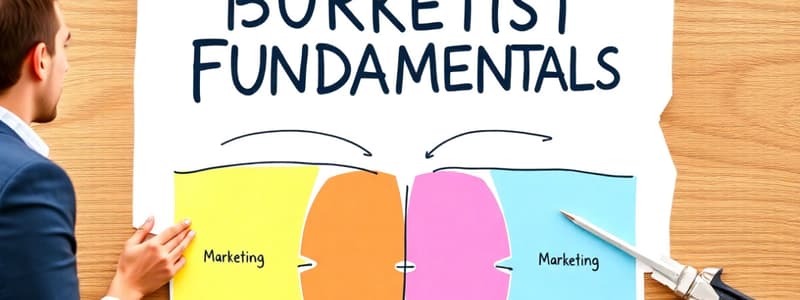Podcast
Questions and Answers
What term describes something that is essential for a person's survival?
What term describes something that is essential for a person's survival?
- Wants
- Needs (correct)
- Desires
- Preferences
Which of the following is NOT one of the 4Ps of the marketing mix?
Which of the following is NOT one of the 4Ps of the marketing mix?
- Product
- Promotion
- Profit (correct)
- Price
Which pricing strategy involves adding a fixed percentage markup to a product's cost?
Which pricing strategy involves adding a fixed percentage markup to a product's cost?
- Loss leader
- Cost-plus pricing (correct)
- Discrimination pricing
- Psychological pricing
Who is considered an entrepreneur?
Who is considered an entrepreneur?
Which type of product is characterized by having a finite or relatively short shelf life?
Which type of product is characterized by having a finite or relatively short shelf life?
What is one of the aims of promotion?
What is one of the aims of promotion?
Which of the following best describes 'wholesalers'?
Which of the following best describes 'wholesalers'?
What does the 'A' in the AIDA marketing model represent?
What does the 'A' in the AIDA marketing model represent?
Flashcards
Needs
Needs
Goods or services that customers need for survival.
Wants
Wants
Goods or services that customers desire, but they are not essential for survival.
Pricing Strategy
Pricing Strategy
The combination of factors that determine the price of a product.
Cost-Plus Pricing
Cost-Plus Pricing
Signup and view all the flashcards
Psychological Pricing
Psychological Pricing
Signup and view all the flashcards
Discrimination Pricing
Discrimination Pricing
Signup and view all the flashcards
Promotion
Promotion
Signup and view all the flashcards
AIDA Model
AIDA Model
Signup and view all the flashcards
Study Notes
Customer Needs
- Needs are essential for survival
- Wants are desires, not essential
- Businesses satisfy emotional, functional, social, convenience, and health needs
- 4 factors of production: land, labor, capital, entrepreneurship
Entrepreneurs
- Entrepreneur: a person who starts and manages a business, taking on the risk of financial market operations, hoping for a profit.
- Real-world examples: Andrew Carnegie, Jeff Bezos, Mark Zuckerberg
Marketing Mix (4Ps)
- Product, Price, Place, Promotion
Product
- Fast-moving consumer goods (FCMGs): quickly sold, inexpensive products (e.g., beans)
- Consumer perishables: short shelf life (e.g., flowers)
- Consumer durables: long shelf life, infrequent replacement (e.g., books, household items)
- Specialty products: unique characteristics or brand identification (e.g., Gucci)
Price
- Cost-plus pricing: selling price determined by adding a percentage markup to the cost
- Psychological pricing: lowering the price to a number lower than a whole number
- Discrimination pricing: pricing strategy based on different customer segments or situations
- Loss leader: selling a product at a loss to attract customers
Promotion
- Promotion is persuading customers to buy products or services to increase sales
- Promotion methods: email marketing, advertising, direct marketing, social media, sponsorships
- Aims of promotion: increase sales, build brand awareness, build customer loyalty
- AIDA: Attention, Interest, Desire, Action
Place (Distribution)
- Retailers: sell goods to the public in relatively small quantities
- Wholesalers: buy goods in bulk and resell to retailers
- Zero level channel: direct distribution from manufacturer to customer
- One level channel: one intermediary (e.g., retailer) between manufacturer and customer
- Two level channel: two intermediaries (e.g., wholesaler and retailer) between manufacturer and customer
Revenue and Market Share
- Revenue: total money brought in by a company
- Market share: percentage of total sales in an industry generated by a company
Studying That Suits You
Use AI to generate personalized quizzes and flashcards to suit your learning preferences.
Related Documents
Description
Explore the essential concepts of customer needs, entrepreneurship, and the marketing mix with this quiz. Dive into the definitions and examples of various products, pricing strategies, and the role of entrepreneurs in the market. Test your knowledge and understanding of these fundamental business principles.




